Tackling the Refugee Crisis: EU Intervention, Challenges & Outcomes
VerifiedAdded on 2023/06/12
|9
|2644
|267
Essay
AI Summary
This essay provides a comprehensive analysis of the European refugee crisis and the European Union's intervention strategies. It begins by defining refugees and outlining the scale of the global refugee crisis, with a specific focus on the influx of asylum seekers into Europe starting in 2015. The essay details the EU's policy responses, including the European Agenda on Migration, which aims to address the crisis both within and outside EU borders through saving lives, addressing the root causes of migration, reducing uncontrolled flows, safeguarding borders, and ensuring safe passages. It also highlights the unintended consequences of these policies, such as the economic strain on host countries, cultural and political tensions, asylum shopping, and security concerns. The essay concludes by emphasizing the need for a balanced approach that combines humanitarian efforts with security measures and addresses the underlying causes of displacement while acknowledging the challenges of integrating refugees into European societies. Desklib offers a wide range of similar essays and study tools for students.
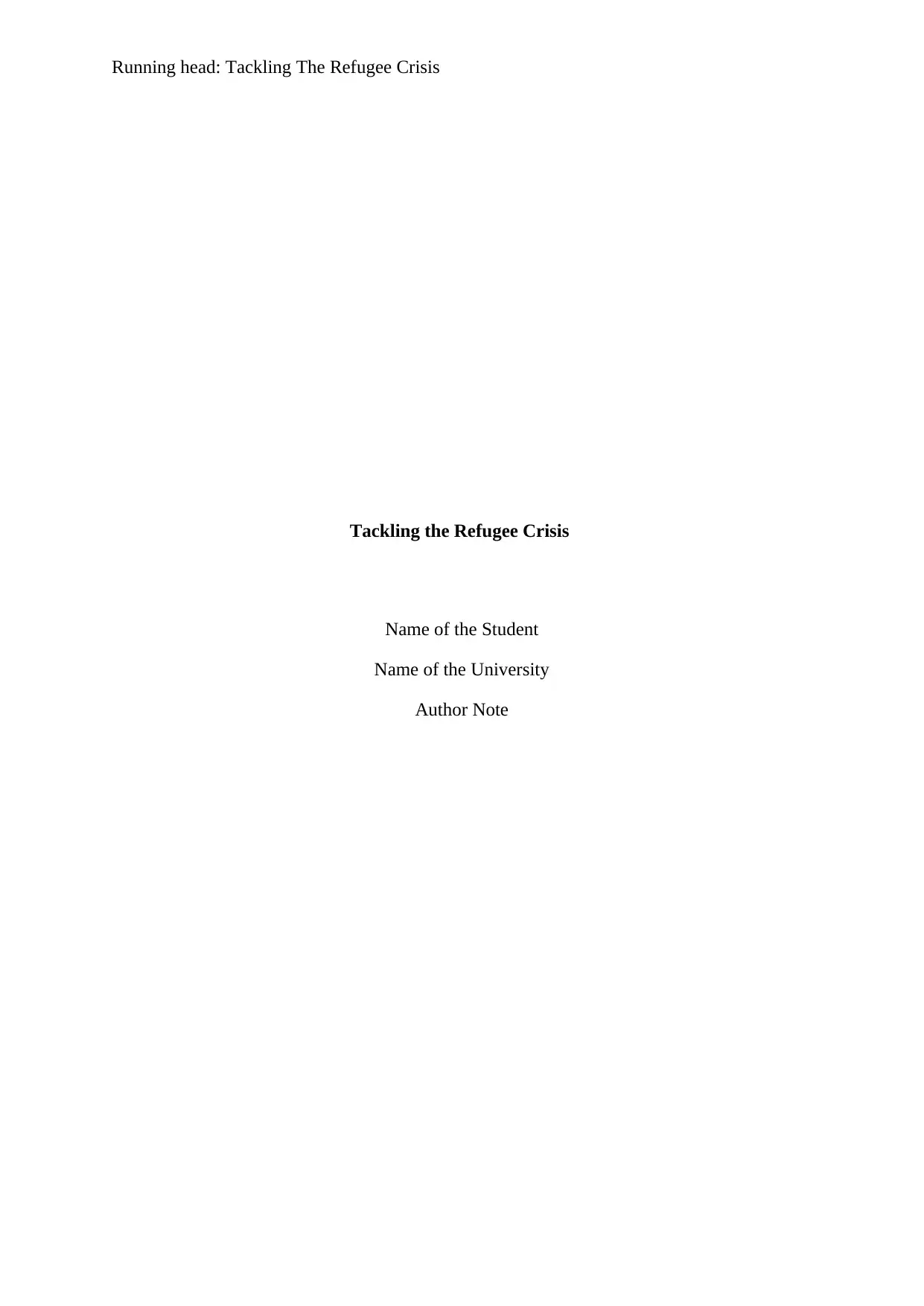
Running head: Tackling The Refugee Crisis
Tackling the Refugee Crisis
Name of the Student
Name of the University
Author Note
Tackling the Refugee Crisis
Name of the Student
Name of the University
Author Note
Paraphrase This Document
Need a fresh take? Get an instant paraphrase of this document with our AI Paraphraser
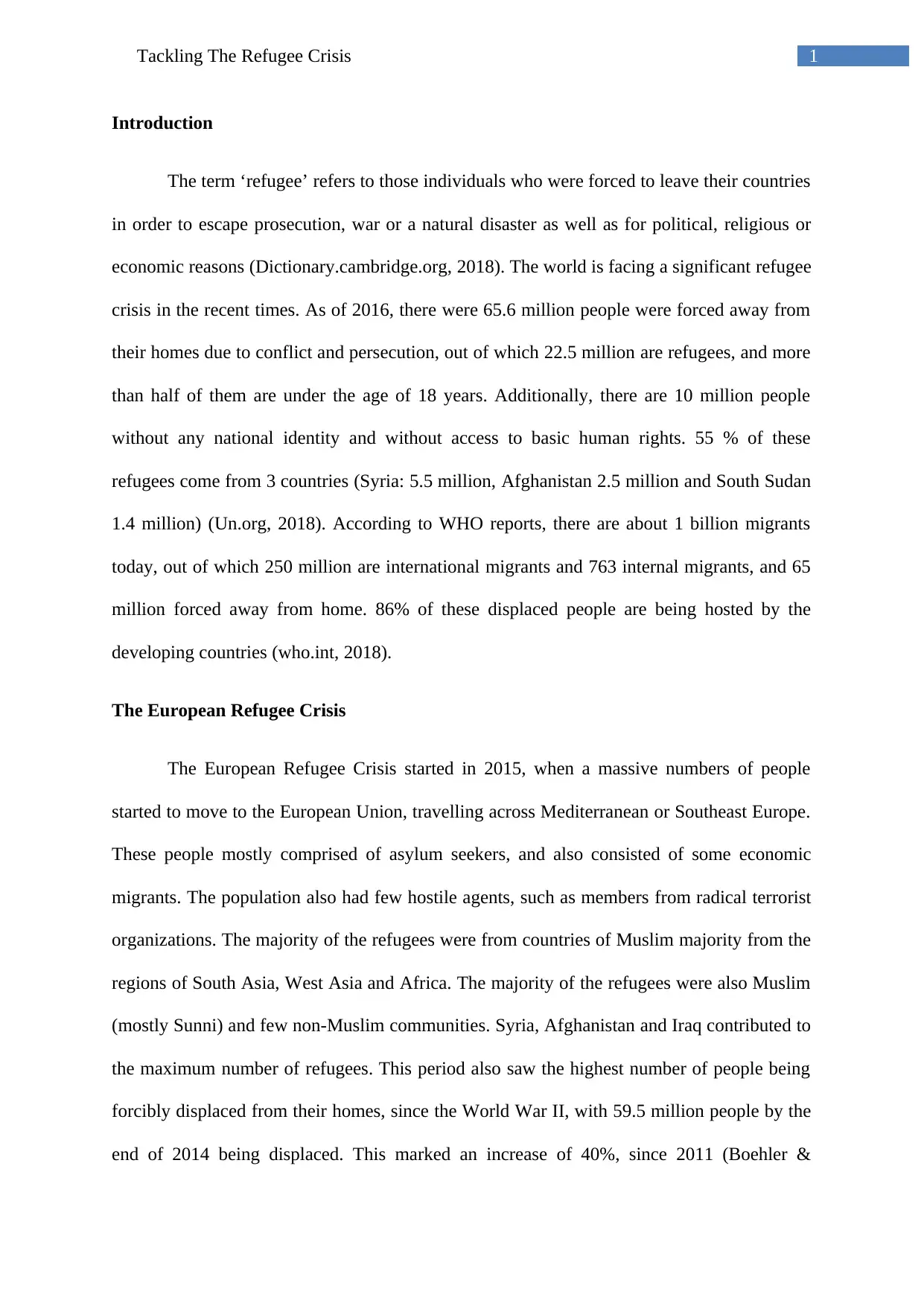
1Tackling The Refugee Crisis
Introduction
The term ‘refugee’ refers to those individuals who were forced to leave their countries
in order to escape prosecution, war or a natural disaster as well as for political, religious or
economic reasons (Dictionary.cambridge.org, 2018). The world is facing a significant refugee
crisis in the recent times. As of 2016, there were 65.6 million people were forced away from
their homes due to conflict and persecution, out of which 22.5 million are refugees, and more
than half of them are under the age of 18 years. Additionally, there are 10 million people
without any national identity and without access to basic human rights. 55 % of these
refugees come from 3 countries (Syria: 5.5 million, Afghanistan 2.5 million and South Sudan
1.4 million) (Un.org, 2018). According to WHO reports, there are about 1 billion migrants
today, out of which 250 million are international migrants and 763 internal migrants, and 65
million forced away from home. 86% of these displaced people are being hosted by the
developing countries (who.int, 2018).
The European Refugee Crisis
The European Refugee Crisis started in 2015, when a massive numbers of people
started to move to the European Union, travelling across Mediterranean or Southeast Europe.
These people mostly comprised of asylum seekers, and also consisted of some economic
migrants. The population also had few hostile agents, such as members from radical terrorist
organizations. The majority of the refugees were from countries of Muslim majority from the
regions of South Asia, West Asia and Africa. The majority of the refugees were also Muslim
(mostly Sunni) and few non-Muslim communities. Syria, Afghanistan and Iraq contributed to
the maximum number of refugees. This period also saw the highest number of people being
forcibly displaced from their homes, since the World War II, with 59.5 million people by the
end of 2014 being displaced. This marked an increase of 40%, since 2011 (Boehler &
Introduction
The term ‘refugee’ refers to those individuals who were forced to leave their countries
in order to escape prosecution, war or a natural disaster as well as for political, religious or
economic reasons (Dictionary.cambridge.org, 2018). The world is facing a significant refugee
crisis in the recent times. As of 2016, there were 65.6 million people were forced away from
their homes due to conflict and persecution, out of which 22.5 million are refugees, and more
than half of them are under the age of 18 years. Additionally, there are 10 million people
without any national identity and without access to basic human rights. 55 % of these
refugees come from 3 countries (Syria: 5.5 million, Afghanistan 2.5 million and South Sudan
1.4 million) (Un.org, 2018). According to WHO reports, there are about 1 billion migrants
today, out of which 250 million are international migrants and 763 internal migrants, and 65
million forced away from home. 86% of these displaced people are being hosted by the
developing countries (who.int, 2018).
The European Refugee Crisis
The European Refugee Crisis started in 2015, when a massive numbers of people
started to move to the European Union, travelling across Mediterranean or Southeast Europe.
These people mostly comprised of asylum seekers, and also consisted of some economic
migrants. The population also had few hostile agents, such as members from radical terrorist
organizations. The majority of the refugees were from countries of Muslim majority from the
regions of South Asia, West Asia and Africa. The majority of the refugees were also Muslim
(mostly Sunni) and few non-Muslim communities. Syria, Afghanistan and Iraq contributed to
the maximum number of refugees. This period also saw the highest number of people being
forcibly displaced from their homes, since the World War II, with 59.5 million people by the
end of 2014 being displaced. This marked an increase of 40%, since 2011 (Boehler &
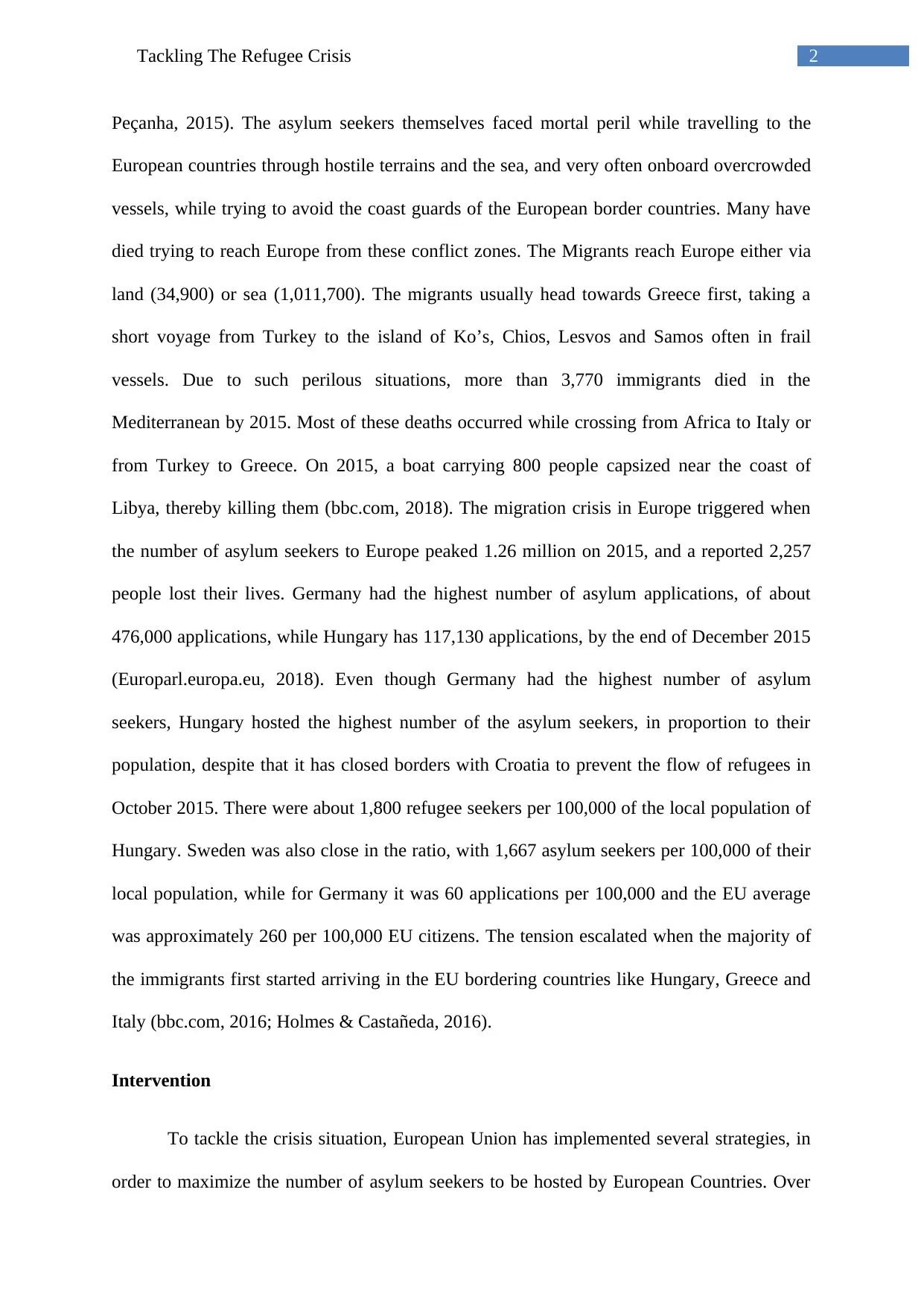
2Tackling The Refugee Crisis
Peçanha, 2015). The asylum seekers themselves faced mortal peril while travelling to the
European countries through hostile terrains and the sea, and very often onboard overcrowded
vessels, while trying to avoid the coast guards of the European border countries. Many have
died trying to reach Europe from these conflict zones. The Migrants reach Europe either via
land (34,900) or sea (1,011,700). The migrants usually head towards Greece first, taking a
short voyage from Turkey to the island of Ko’s, Chios, Lesvos and Samos often in frail
vessels. Due to such perilous situations, more than 3,770 immigrants died in the
Mediterranean by 2015. Most of these deaths occurred while crossing from Africa to Italy or
from Turkey to Greece. On 2015, a boat carrying 800 people capsized near the coast of
Libya, thereby killing them (bbc.com, 2018). The migration crisis in Europe triggered when
the number of asylum seekers to Europe peaked 1.26 million on 2015, and a reported 2,257
people lost their lives. Germany had the highest number of asylum applications, of about
476,000 applications, while Hungary has 117,130 applications, by the end of December 2015
(Europarl.europa.eu, 2018). Even though Germany had the highest number of asylum
seekers, Hungary hosted the highest number of the asylum seekers, in proportion to their
population, despite that it has closed borders with Croatia to prevent the flow of refugees in
October 2015. There were about 1,800 refugee seekers per 100,000 of the local population of
Hungary. Sweden was also close in the ratio, with 1,667 asylum seekers per 100,000 of their
local population, while for Germany it was 60 applications per 100,000 and the EU average
was approximately 260 per 100,000 EU citizens. The tension escalated when the majority of
the immigrants first started arriving in the EU bordering countries like Hungary, Greece and
Italy (bbc.com, 2016; Holmes & Castañeda, 2016).
Intervention
To tackle the crisis situation, European Union has implemented several strategies, in
order to maximize the number of asylum seekers to be hosted by European Countries. Over
Peçanha, 2015). The asylum seekers themselves faced mortal peril while travelling to the
European countries through hostile terrains and the sea, and very often onboard overcrowded
vessels, while trying to avoid the coast guards of the European border countries. Many have
died trying to reach Europe from these conflict zones. The Migrants reach Europe either via
land (34,900) or sea (1,011,700). The migrants usually head towards Greece first, taking a
short voyage from Turkey to the island of Ko’s, Chios, Lesvos and Samos often in frail
vessels. Due to such perilous situations, more than 3,770 immigrants died in the
Mediterranean by 2015. Most of these deaths occurred while crossing from Africa to Italy or
from Turkey to Greece. On 2015, a boat carrying 800 people capsized near the coast of
Libya, thereby killing them (bbc.com, 2018). The migration crisis in Europe triggered when
the number of asylum seekers to Europe peaked 1.26 million on 2015, and a reported 2,257
people lost their lives. Germany had the highest number of asylum applications, of about
476,000 applications, while Hungary has 117,130 applications, by the end of December 2015
(Europarl.europa.eu, 2018). Even though Germany had the highest number of asylum
seekers, Hungary hosted the highest number of the asylum seekers, in proportion to their
population, despite that it has closed borders with Croatia to prevent the flow of refugees in
October 2015. There were about 1,800 refugee seekers per 100,000 of the local population of
Hungary. Sweden was also close in the ratio, with 1,667 asylum seekers per 100,000 of their
local population, while for Germany it was 60 applications per 100,000 and the EU average
was approximately 260 per 100,000 EU citizens. The tension escalated when the majority of
the immigrants first started arriving in the EU bordering countries like Hungary, Greece and
Italy (bbc.com, 2016; Holmes & Castañeda, 2016).
Intervention
To tackle the crisis situation, European Union has implemented several strategies, in
order to maximize the number of asylum seekers to be hosted by European Countries. Over
⊘ This is a preview!⊘
Do you want full access?
Subscribe today to unlock all pages.

Trusted by 1+ million students worldwide
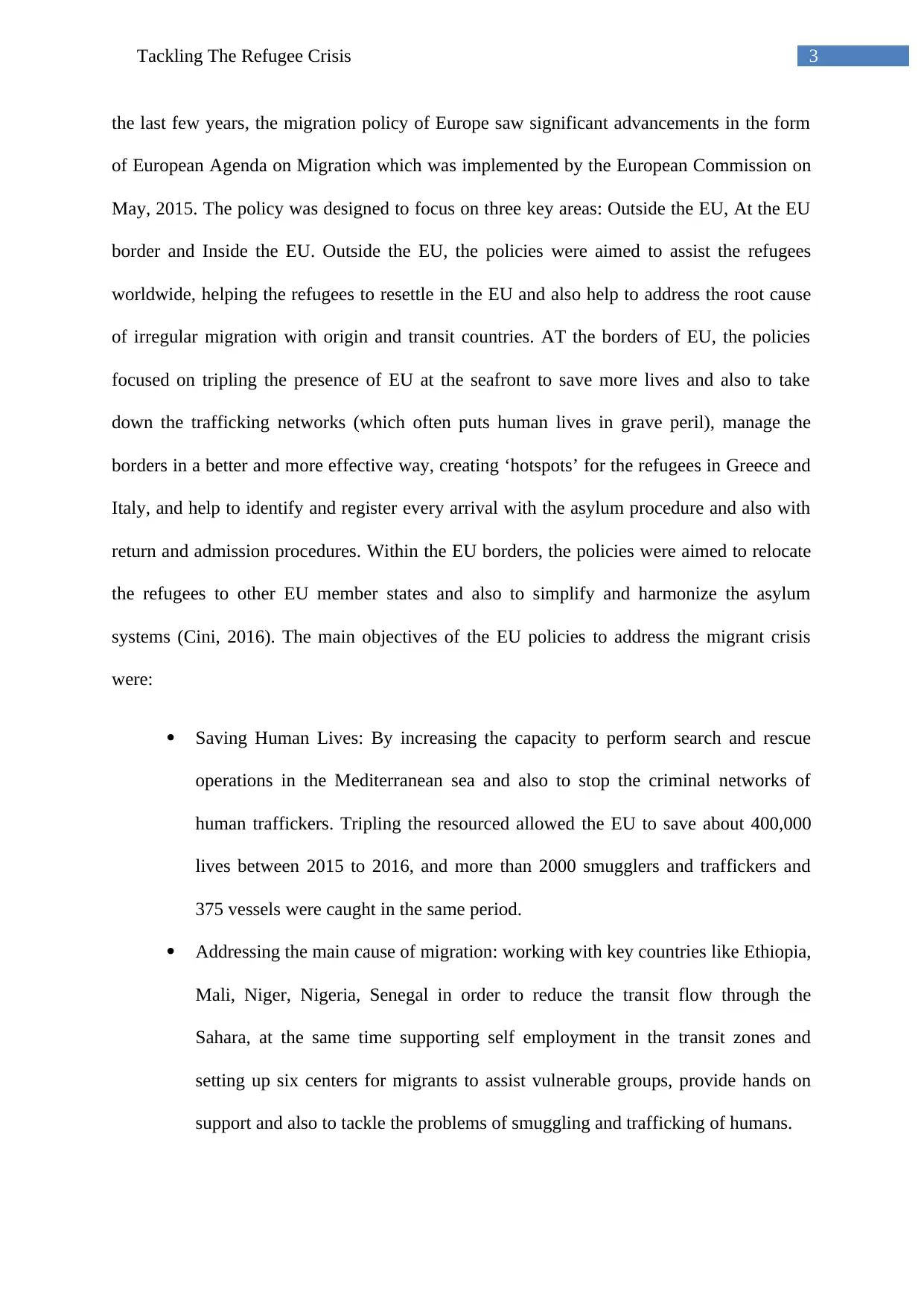
3Tackling The Refugee Crisis
the last few years, the migration policy of Europe saw significant advancements in the form
of European Agenda on Migration which was implemented by the European Commission on
May, 2015. The policy was designed to focus on three key areas: Outside the EU, At the EU
border and Inside the EU. Outside the EU, the policies were aimed to assist the refugees
worldwide, helping the refugees to resettle in the EU and also help to address the root cause
of irregular migration with origin and transit countries. AT the borders of EU, the policies
focused on tripling the presence of EU at the seafront to save more lives and also to take
down the trafficking networks (which often puts human lives in grave peril), manage the
borders in a better and more effective way, creating ‘hotspots’ for the refugees in Greece and
Italy, and help to identify and register every arrival with the asylum procedure and also with
return and admission procedures. Within the EU borders, the policies were aimed to relocate
the refugees to other EU member states and also to simplify and harmonize the asylum
systems (Cini, 2016). The main objectives of the EU policies to address the migrant crisis
were:
Saving Human Lives: By increasing the capacity to perform search and rescue
operations in the Mediterranean sea and also to stop the criminal networks of
human traffickers. Tripling the resourced allowed the EU to save about 400,000
lives between 2015 to 2016, and more than 2000 smugglers and traffickers and
375 vessels were caught in the same period.
Addressing the main cause of migration: working with key countries like Ethiopia,
Mali, Niger, Nigeria, Senegal in order to reduce the transit flow through the
Sahara, at the same time supporting self employment in the transit zones and
setting up six centers for migrants to assist vulnerable groups, provide hands on
support and also to tackle the problems of smuggling and trafficking of humans.
the last few years, the migration policy of Europe saw significant advancements in the form
of European Agenda on Migration which was implemented by the European Commission on
May, 2015. The policy was designed to focus on three key areas: Outside the EU, At the EU
border and Inside the EU. Outside the EU, the policies were aimed to assist the refugees
worldwide, helping the refugees to resettle in the EU and also help to address the root cause
of irregular migration with origin and transit countries. AT the borders of EU, the policies
focused on tripling the presence of EU at the seafront to save more lives and also to take
down the trafficking networks (which often puts human lives in grave peril), manage the
borders in a better and more effective way, creating ‘hotspots’ for the refugees in Greece and
Italy, and help to identify and register every arrival with the asylum procedure and also with
return and admission procedures. Within the EU borders, the policies were aimed to relocate
the refugees to other EU member states and also to simplify and harmonize the asylum
systems (Cini, 2016). The main objectives of the EU policies to address the migrant crisis
were:
Saving Human Lives: By increasing the capacity to perform search and rescue
operations in the Mediterranean sea and also to stop the criminal networks of
human traffickers. Tripling the resourced allowed the EU to save about 400,000
lives between 2015 to 2016, and more than 2000 smugglers and traffickers and
375 vessels were caught in the same period.
Addressing the main cause of migration: working with key countries like Ethiopia,
Mali, Niger, Nigeria, Senegal in order to reduce the transit flow through the
Sahara, at the same time supporting self employment in the transit zones and
setting up six centers for migrants to assist vulnerable groups, provide hands on
support and also to tackle the problems of smuggling and trafficking of humans.
Paraphrase This Document
Need a fresh take? Get an instant paraphrase of this document with our AI Paraphraser
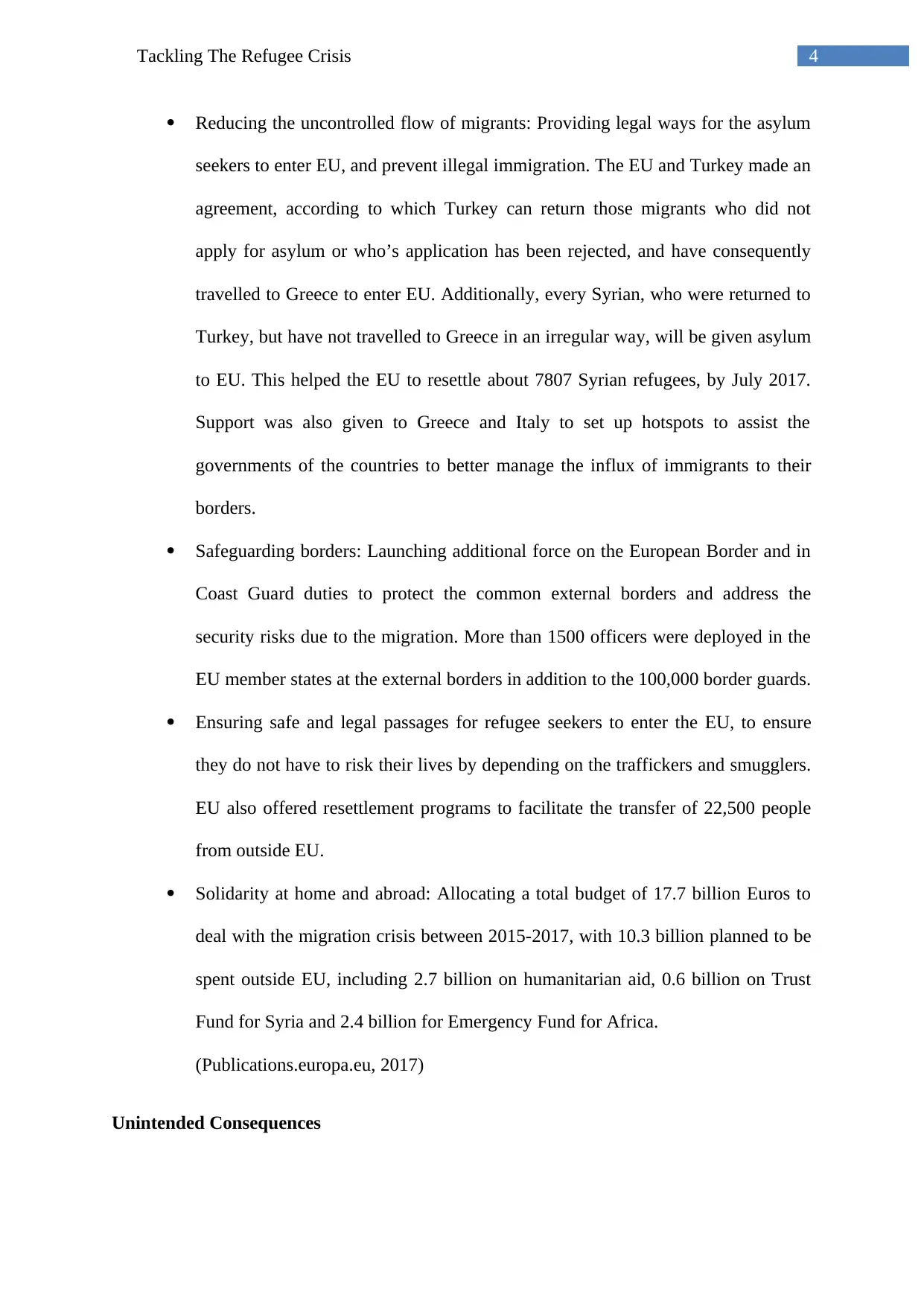
4Tackling The Refugee Crisis
Reducing the uncontrolled flow of migrants: Providing legal ways for the asylum
seekers to enter EU, and prevent illegal immigration. The EU and Turkey made an
agreement, according to which Turkey can return those migrants who did not
apply for asylum or who’s application has been rejected, and have consequently
travelled to Greece to enter EU. Additionally, every Syrian, who were returned to
Turkey, but have not travelled to Greece in an irregular way, will be given asylum
to EU. This helped the EU to resettle about 7807 Syrian refugees, by July 2017.
Support was also given to Greece and Italy to set up hotspots to assist the
governments of the countries to better manage the influx of immigrants to their
borders.
Safeguarding borders: Launching additional force on the European Border and in
Coast Guard duties to protect the common external borders and address the
security risks due to the migration. More than 1500 officers were deployed in the
EU member states at the external borders in addition to the 100,000 border guards.
Ensuring safe and legal passages for refugee seekers to enter the EU, to ensure
they do not have to risk their lives by depending on the traffickers and smugglers.
EU also offered resettlement programs to facilitate the transfer of 22,500 people
from outside EU.
Solidarity at home and abroad: Allocating a total budget of 17.7 billion Euros to
deal with the migration crisis between 2015-2017, with 10.3 billion planned to be
spent outside EU, including 2.7 billion on humanitarian aid, 0.6 billion on Trust
Fund for Syria and 2.4 billion for Emergency Fund for Africa.
(Publications.europa.eu, 2017)
Unintended Consequences
Reducing the uncontrolled flow of migrants: Providing legal ways for the asylum
seekers to enter EU, and prevent illegal immigration. The EU and Turkey made an
agreement, according to which Turkey can return those migrants who did not
apply for asylum or who’s application has been rejected, and have consequently
travelled to Greece to enter EU. Additionally, every Syrian, who were returned to
Turkey, but have not travelled to Greece in an irregular way, will be given asylum
to EU. This helped the EU to resettle about 7807 Syrian refugees, by July 2017.
Support was also given to Greece and Italy to set up hotspots to assist the
governments of the countries to better manage the influx of immigrants to their
borders.
Safeguarding borders: Launching additional force on the European Border and in
Coast Guard duties to protect the common external borders and address the
security risks due to the migration. More than 1500 officers were deployed in the
EU member states at the external borders in addition to the 100,000 border guards.
Ensuring safe and legal passages for refugee seekers to enter the EU, to ensure
they do not have to risk their lives by depending on the traffickers and smugglers.
EU also offered resettlement programs to facilitate the transfer of 22,500 people
from outside EU.
Solidarity at home and abroad: Allocating a total budget of 17.7 billion Euros to
deal with the migration crisis between 2015-2017, with 10.3 billion planned to be
spent outside EU, including 2.7 billion on humanitarian aid, 0.6 billion on Trust
Fund for Syria and 2.4 billion for Emergency Fund for Africa.
(Publications.europa.eu, 2017)
Unintended Consequences
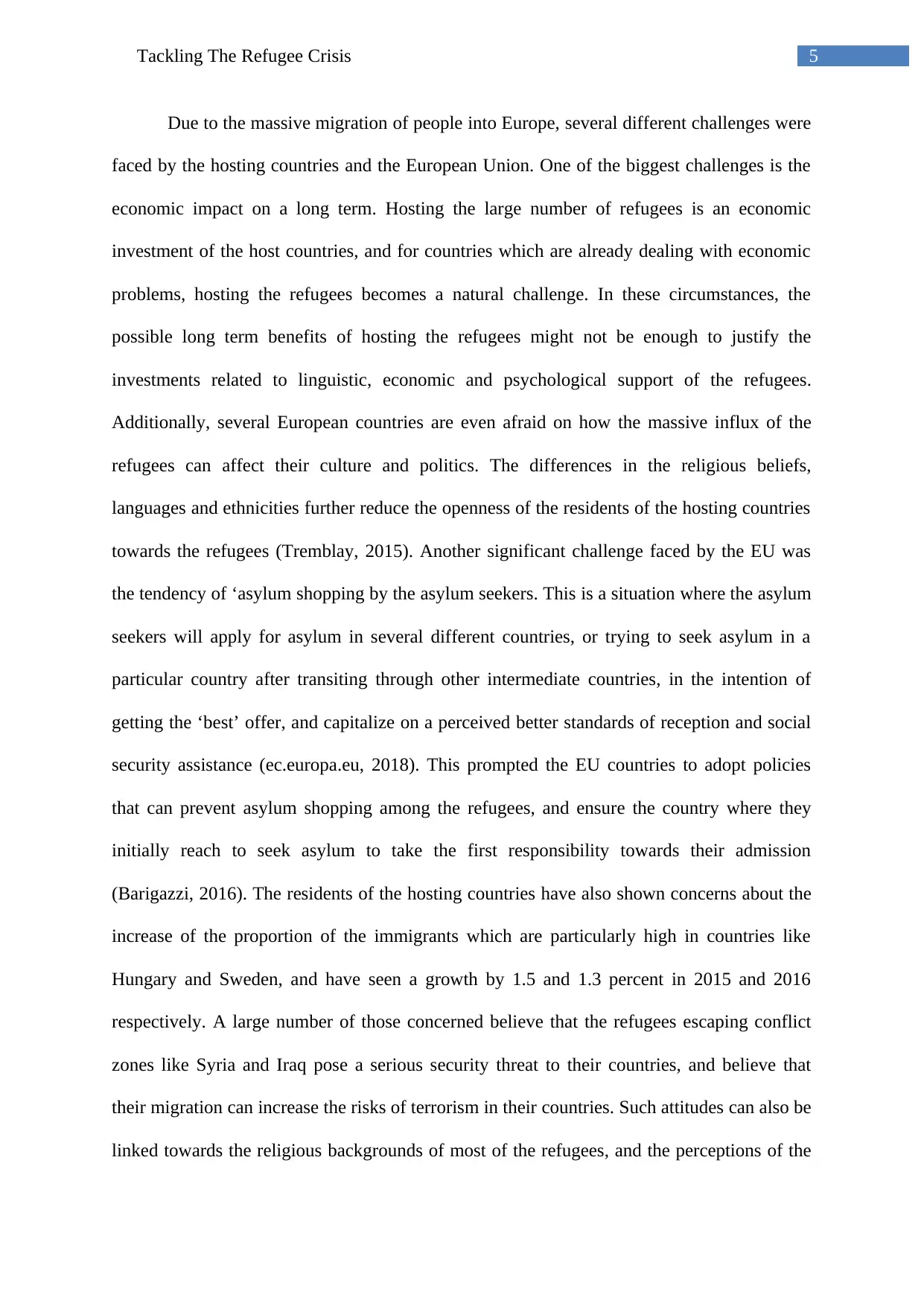
5Tackling The Refugee Crisis
Due to the massive migration of people into Europe, several different challenges were
faced by the hosting countries and the European Union. One of the biggest challenges is the
economic impact on a long term. Hosting the large number of refugees is an economic
investment of the host countries, and for countries which are already dealing with economic
problems, hosting the refugees becomes a natural challenge. In these circumstances, the
possible long term benefits of hosting the refugees might not be enough to justify the
investments related to linguistic, economic and psychological support of the refugees.
Additionally, several European countries are even afraid on how the massive influx of the
refugees can affect their culture and politics. The differences in the religious beliefs,
languages and ethnicities further reduce the openness of the residents of the hosting countries
towards the refugees (Tremblay, 2015). Another significant challenge faced by the EU was
the tendency of ‘asylum shopping by the asylum seekers. This is a situation where the asylum
seekers will apply for asylum in several different countries, or trying to seek asylum in a
particular country after transiting through other intermediate countries, in the intention of
getting the ‘best’ offer, and capitalize on a perceived better standards of reception and social
security assistance (ec.europa.eu, 2018). This prompted the EU countries to adopt policies
that can prevent asylum shopping among the refugees, and ensure the country where they
initially reach to seek asylum to take the first responsibility towards their admission
(Barigazzi, 2016). The residents of the hosting countries have also shown concerns about the
increase of the proportion of the immigrants which are particularly high in countries like
Hungary and Sweden, and have seen a growth by 1.5 and 1.3 percent in 2015 and 2016
respectively. A large number of those concerned believe that the refugees escaping conflict
zones like Syria and Iraq pose a serious security threat to their countries, and believe that
their migration can increase the risks of terrorism in their countries. Such attitudes can also be
linked towards the religious backgrounds of most of the refugees, and the perceptions of the
Due to the massive migration of people into Europe, several different challenges were
faced by the hosting countries and the European Union. One of the biggest challenges is the
economic impact on a long term. Hosting the large number of refugees is an economic
investment of the host countries, and for countries which are already dealing with economic
problems, hosting the refugees becomes a natural challenge. In these circumstances, the
possible long term benefits of hosting the refugees might not be enough to justify the
investments related to linguistic, economic and psychological support of the refugees.
Additionally, several European countries are even afraid on how the massive influx of the
refugees can affect their culture and politics. The differences in the religious beliefs,
languages and ethnicities further reduce the openness of the residents of the hosting countries
towards the refugees (Tremblay, 2015). Another significant challenge faced by the EU was
the tendency of ‘asylum shopping by the asylum seekers. This is a situation where the asylum
seekers will apply for asylum in several different countries, or trying to seek asylum in a
particular country after transiting through other intermediate countries, in the intention of
getting the ‘best’ offer, and capitalize on a perceived better standards of reception and social
security assistance (ec.europa.eu, 2018). This prompted the EU countries to adopt policies
that can prevent asylum shopping among the refugees, and ensure the country where they
initially reach to seek asylum to take the first responsibility towards their admission
(Barigazzi, 2016). The residents of the hosting countries have also shown concerns about the
increase of the proportion of the immigrants which are particularly high in countries like
Hungary and Sweden, and have seen a growth by 1.5 and 1.3 percent in 2015 and 2016
respectively. A large number of those concerned believe that the refugees escaping conflict
zones like Syria and Iraq pose a serious security threat to their countries, and believe that
their migration can increase the risks of terrorism in their countries. Such attitudes can also be
linked towards the religious backgrounds of most of the refugees, and the perceptions of the
⊘ This is a preview!⊘
Do you want full access?
Subscribe today to unlock all pages.

Trusted by 1+ million students worldwide
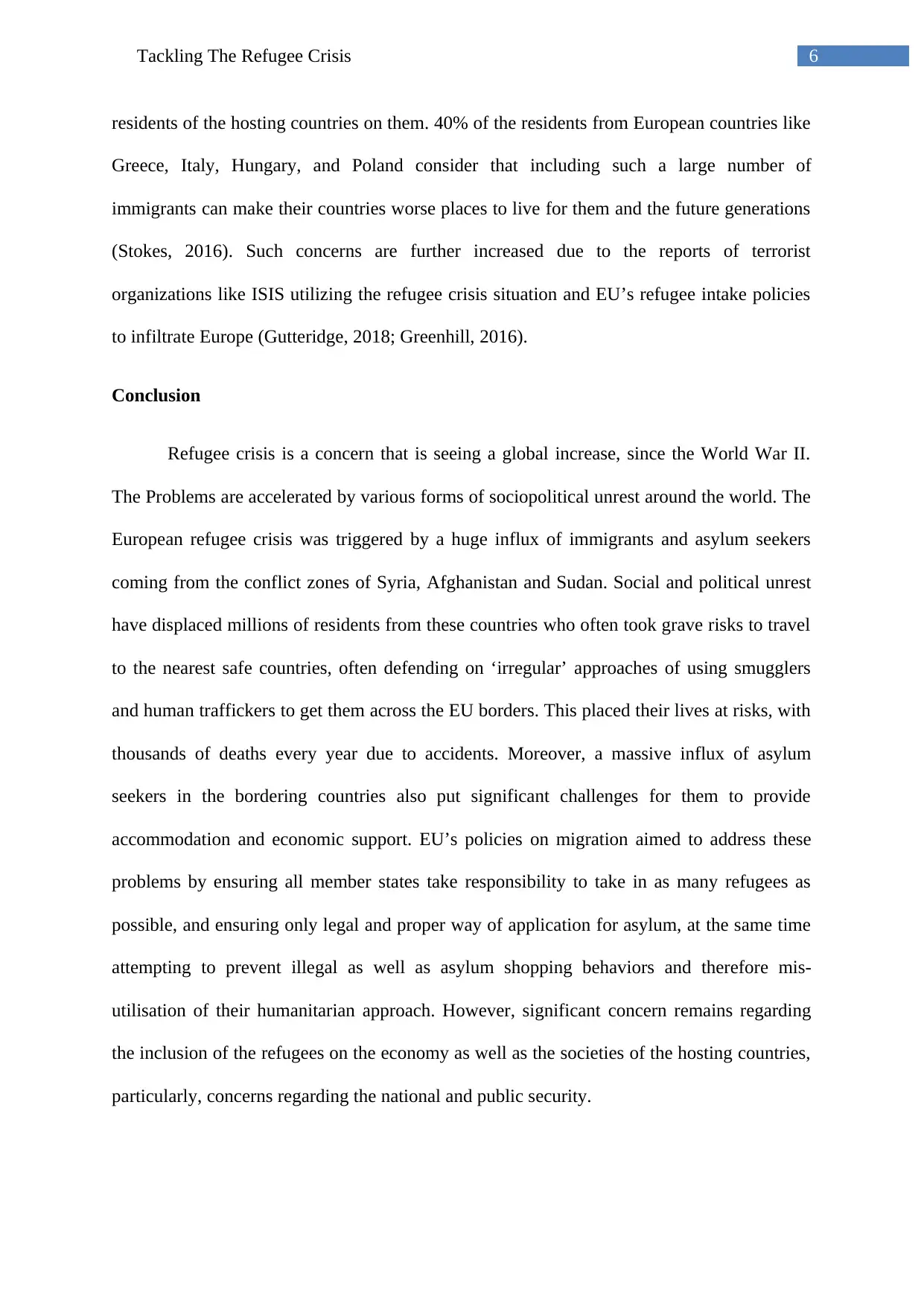
6Tackling The Refugee Crisis
residents of the hosting countries on them. 40% of the residents from European countries like
Greece, Italy, Hungary, and Poland consider that including such a large number of
immigrants can make their countries worse places to live for them and the future generations
(Stokes, 2016). Such concerns are further increased due to the reports of terrorist
organizations like ISIS utilizing the refugee crisis situation and EU’s refugee intake policies
to infiltrate Europe (Gutteridge, 2018; Greenhill, 2016).
Conclusion
Refugee crisis is a concern that is seeing a global increase, since the World War II.
The Problems are accelerated by various forms of sociopolitical unrest around the world. The
European refugee crisis was triggered by a huge influx of immigrants and asylum seekers
coming from the conflict zones of Syria, Afghanistan and Sudan. Social and political unrest
have displaced millions of residents from these countries who often took grave risks to travel
to the nearest safe countries, often defending on ‘irregular’ approaches of using smugglers
and human traffickers to get them across the EU borders. This placed their lives at risks, with
thousands of deaths every year due to accidents. Moreover, a massive influx of asylum
seekers in the bordering countries also put significant challenges for them to provide
accommodation and economic support. EU’s policies on migration aimed to address these
problems by ensuring all member states take responsibility to take in as many refugees as
possible, and ensuring only legal and proper way of application for asylum, at the same time
attempting to prevent illegal as well as asylum shopping behaviors and therefore mis-
utilisation of their humanitarian approach. However, significant concern remains regarding
the inclusion of the refugees on the economy as well as the societies of the hosting countries,
particularly, concerns regarding the national and public security.
residents of the hosting countries on them. 40% of the residents from European countries like
Greece, Italy, Hungary, and Poland consider that including such a large number of
immigrants can make their countries worse places to live for them and the future generations
(Stokes, 2016). Such concerns are further increased due to the reports of terrorist
organizations like ISIS utilizing the refugee crisis situation and EU’s refugee intake policies
to infiltrate Europe (Gutteridge, 2018; Greenhill, 2016).
Conclusion
Refugee crisis is a concern that is seeing a global increase, since the World War II.
The Problems are accelerated by various forms of sociopolitical unrest around the world. The
European refugee crisis was triggered by a huge influx of immigrants and asylum seekers
coming from the conflict zones of Syria, Afghanistan and Sudan. Social and political unrest
have displaced millions of residents from these countries who often took grave risks to travel
to the nearest safe countries, often defending on ‘irregular’ approaches of using smugglers
and human traffickers to get them across the EU borders. This placed their lives at risks, with
thousands of deaths every year due to accidents. Moreover, a massive influx of asylum
seekers in the bordering countries also put significant challenges for them to provide
accommodation and economic support. EU’s policies on migration aimed to address these
problems by ensuring all member states take responsibility to take in as many refugees as
possible, and ensuring only legal and proper way of application for asylum, at the same time
attempting to prevent illegal as well as asylum shopping behaviors and therefore mis-
utilisation of their humanitarian approach. However, significant concern remains regarding
the inclusion of the refugees on the economy as well as the societies of the hosting countries,
particularly, concerns regarding the national and public security.
Paraphrase This Document
Need a fresh take? Get an instant paraphrase of this document with our AI Paraphraser
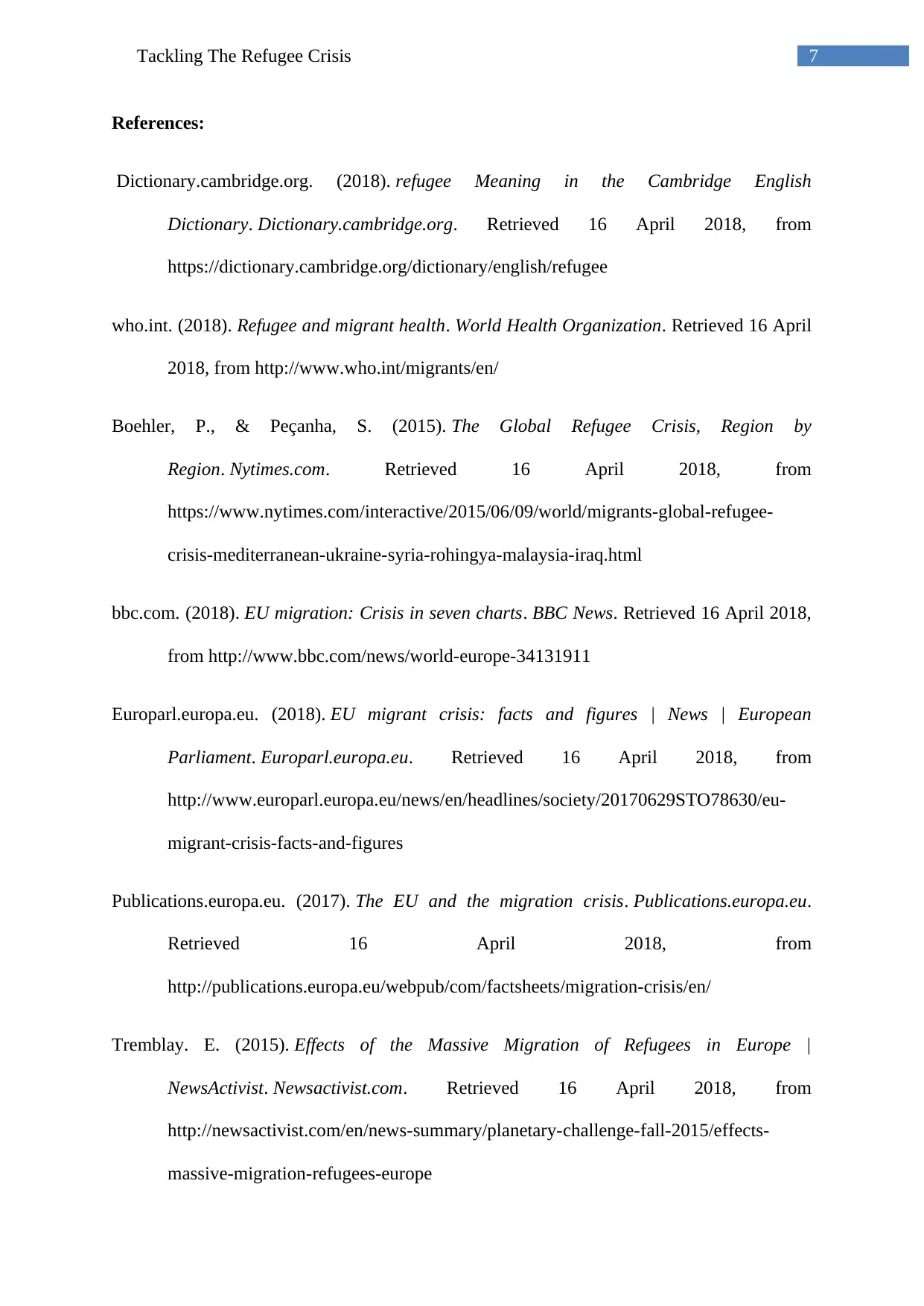
7Tackling The Refugee Crisis
References:
Dictionary.cambridge.org. (2018). refugee Meaning in the Cambridge English
Dictionary. Dictionary.cambridge.org. Retrieved 16 April 2018, from
https://dictionary.cambridge.org/dictionary/english/refugee
who.int. (2018). Refugee and migrant health. World Health Organization. Retrieved 16 April
2018, from http://www.who.int/migrants/en/
Boehler, P., & Peçanha, S. (2015). The Global Refugee Crisis, Region by
Region. Nytimes.com. Retrieved 16 April 2018, from
https://www.nytimes.com/interactive/2015/06/09/world/migrants-global-refugee-
crisis-mediterranean-ukraine-syria-rohingya-malaysia-iraq.html
bbc.com. (2018). EU migration: Crisis in seven charts. BBC News. Retrieved 16 April 2018,
from http://www.bbc.com/news/world-europe-34131911
Europarl.europa.eu. (2018). EU migrant crisis: facts and figures | News | European
Parliament. Europarl.europa.eu. Retrieved 16 April 2018, from
http://www.europarl.europa.eu/news/en/headlines/society/20170629STO78630/eu-
migrant-crisis-facts-and-figures
Publications.europa.eu. (2017). The EU and the migration crisis. Publications.europa.eu.
Retrieved 16 April 2018, from
http://publications.europa.eu/webpub/com/factsheets/migration-crisis/en/
Tremblay. E. (2015). Effects of the Massive Migration of Refugees in Europe |
NewsActivist. Newsactivist.com. Retrieved 16 April 2018, from
http://newsactivist.com/en/news-summary/planetary-challenge-fall-2015/effects-
massive-migration-refugees-europe
References:
Dictionary.cambridge.org. (2018). refugee Meaning in the Cambridge English
Dictionary. Dictionary.cambridge.org. Retrieved 16 April 2018, from
https://dictionary.cambridge.org/dictionary/english/refugee
who.int. (2018). Refugee and migrant health. World Health Organization. Retrieved 16 April
2018, from http://www.who.int/migrants/en/
Boehler, P., & Peçanha, S. (2015). The Global Refugee Crisis, Region by
Region. Nytimes.com. Retrieved 16 April 2018, from
https://www.nytimes.com/interactive/2015/06/09/world/migrants-global-refugee-
crisis-mediterranean-ukraine-syria-rohingya-malaysia-iraq.html
bbc.com. (2018). EU migration: Crisis in seven charts. BBC News. Retrieved 16 April 2018,
from http://www.bbc.com/news/world-europe-34131911
Europarl.europa.eu. (2018). EU migrant crisis: facts and figures | News | European
Parliament. Europarl.europa.eu. Retrieved 16 April 2018, from
http://www.europarl.europa.eu/news/en/headlines/society/20170629STO78630/eu-
migrant-crisis-facts-and-figures
Publications.europa.eu. (2017). The EU and the migration crisis. Publications.europa.eu.
Retrieved 16 April 2018, from
http://publications.europa.eu/webpub/com/factsheets/migration-crisis/en/
Tremblay. E. (2015). Effects of the Massive Migration of Refugees in Europe |
NewsActivist. Newsactivist.com. Retrieved 16 April 2018, from
http://newsactivist.com/en/news-summary/planetary-challenge-fall-2015/effects-
massive-migration-refugees-europe
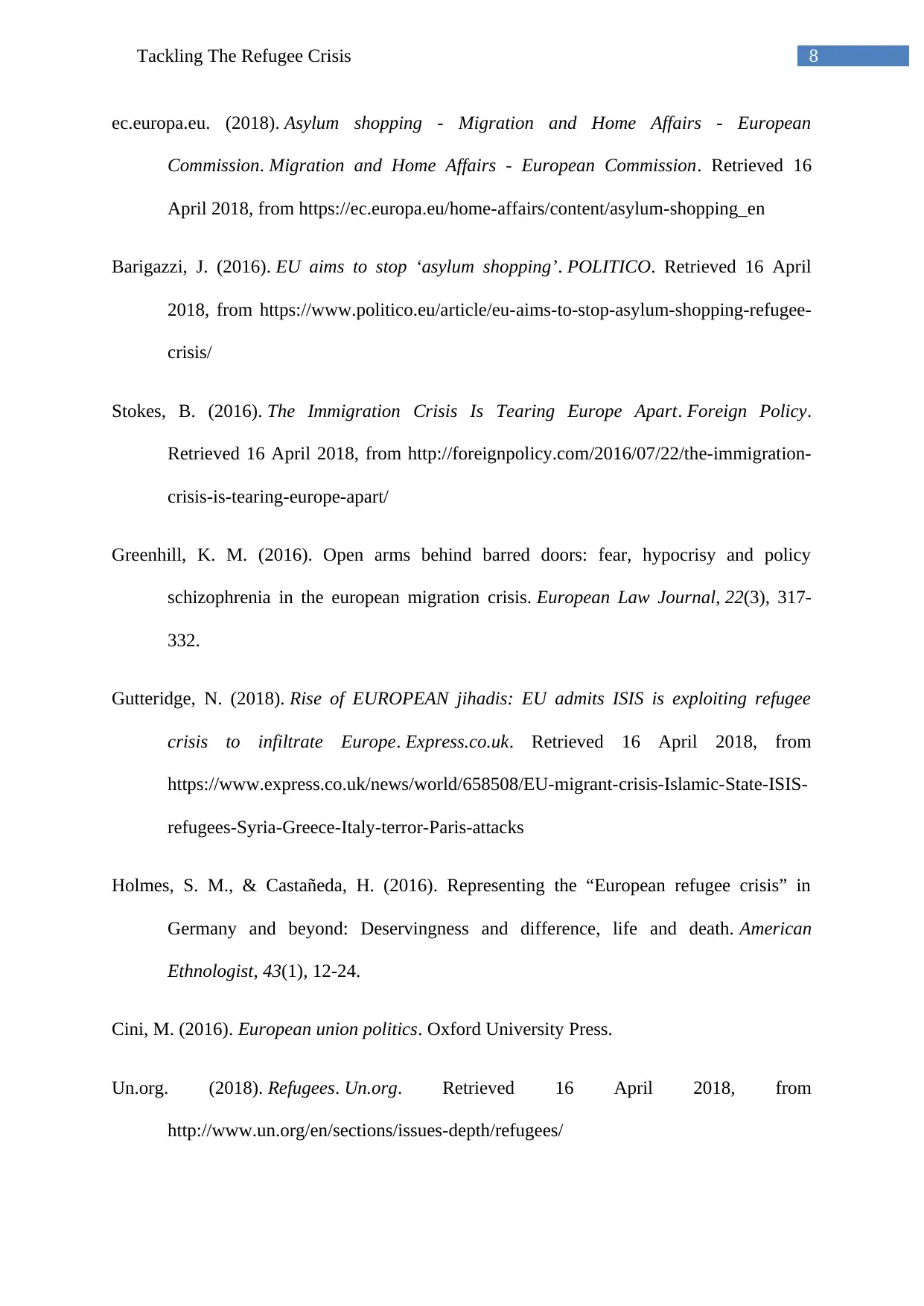
8Tackling The Refugee Crisis
ec.europa.eu. (2018). Asylum shopping - Migration and Home Affairs - European
Commission. Migration and Home Affairs - European Commission. Retrieved 16
April 2018, from https://ec.europa.eu/home-affairs/content/asylum-shopping_en
Barigazzi, J. (2016). EU aims to stop ‘asylum shopping’. POLITICO. Retrieved 16 April
2018, from https://www.politico.eu/article/eu-aims-to-stop-asylum-shopping-refugee-
crisis/
Stokes, B. (2016). The Immigration Crisis Is Tearing Europe Apart. Foreign Policy.
Retrieved 16 April 2018, from http://foreignpolicy.com/2016/07/22/the-immigration-
crisis-is-tearing-europe-apart/
Greenhill, K. M. (2016). Open arms behind barred doors: fear, hypocrisy and policy
schizophrenia in the european migration crisis. European Law Journal, 22(3), 317-
332.
Gutteridge, N. (2018). Rise of EUROPEAN jihadis: EU admits ISIS is exploiting refugee
crisis to infiltrate Europe. Express.co.uk. Retrieved 16 April 2018, from
https://www.express.co.uk/news/world/658508/EU-migrant-crisis-Islamic-State-ISIS-
refugees-Syria-Greece-Italy-terror-Paris-attacks
Holmes, S. M., & Castañeda, H. (2016). Representing the “European refugee crisis” in
Germany and beyond: Deservingness and difference, life and death. American
Ethnologist, 43(1), 12-24.
Cini, M. (2016). European union politics. Oxford University Press.
Un.org. (2018). Refugees. Un.org. Retrieved 16 April 2018, from
http://www.un.org/en/sections/issues-depth/refugees/
ec.europa.eu. (2018). Asylum shopping - Migration and Home Affairs - European
Commission. Migration and Home Affairs - European Commission. Retrieved 16
April 2018, from https://ec.europa.eu/home-affairs/content/asylum-shopping_en
Barigazzi, J. (2016). EU aims to stop ‘asylum shopping’. POLITICO. Retrieved 16 April
2018, from https://www.politico.eu/article/eu-aims-to-stop-asylum-shopping-refugee-
crisis/
Stokes, B. (2016). The Immigration Crisis Is Tearing Europe Apart. Foreign Policy.
Retrieved 16 April 2018, from http://foreignpolicy.com/2016/07/22/the-immigration-
crisis-is-tearing-europe-apart/
Greenhill, K. M. (2016). Open arms behind barred doors: fear, hypocrisy and policy
schizophrenia in the european migration crisis. European Law Journal, 22(3), 317-
332.
Gutteridge, N. (2018). Rise of EUROPEAN jihadis: EU admits ISIS is exploiting refugee
crisis to infiltrate Europe. Express.co.uk. Retrieved 16 April 2018, from
https://www.express.co.uk/news/world/658508/EU-migrant-crisis-Islamic-State-ISIS-
refugees-Syria-Greece-Italy-terror-Paris-attacks
Holmes, S. M., & Castañeda, H. (2016). Representing the “European refugee crisis” in
Germany and beyond: Deservingness and difference, life and death. American
Ethnologist, 43(1), 12-24.
Cini, M. (2016). European union politics. Oxford University Press.
Un.org. (2018). Refugees. Un.org. Retrieved 16 April 2018, from
http://www.un.org/en/sections/issues-depth/refugees/
⊘ This is a preview!⊘
Do you want full access?
Subscribe today to unlock all pages.

Trusted by 1+ million students worldwide
1 out of 9
Related Documents
Your All-in-One AI-Powered Toolkit for Academic Success.
+13062052269
info@desklib.com
Available 24*7 on WhatsApp / Email
![[object Object]](/_next/static/media/star-bottom.7253800d.svg)
Unlock your academic potential
Copyright © 2020–2025 A2Z Services. All Rights Reserved. Developed and managed by ZUCOL.





